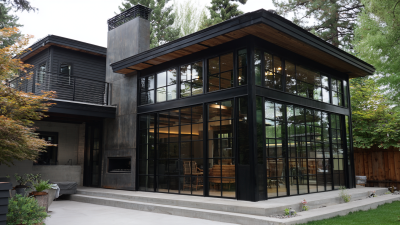Installing a garden window can be a rewarding yet challenging endeavor for homeowners seeking to enhance their living space with natural light and a touch of nature. According to a report by the National Association of Home Builders (NAHB), window replacement is one of the top home improvement projects that yield significant returns on investment, with garden windows offering up to 70% ROI when selling a home. However, the complexity of installation can deter many individuals from undertaking this project. In fact, a survey by the American Institute of Architects revealed that 60% of homeowners report difficulties in managing home improvement projects, particularly when it comes to specialty installations like garden windows. This blog will provide a comprehensive tutorial to help you navigate the common challenges associated with garden window installation, ensuring that you can achieve that perfect sunny nook in your home with confidence and ease.

 Accurate measurements are crucial when installing a garden window, as even minor discrepancies can lead to significant complications. According to a report by the National Association of Home Builders, nearly 30% of construction errors stem from incorrect measurements. This can result in increased costs and extended project timelines, emphasizing the need for precision in the initial stages of installation. A well-measured garden window not only enhances the aesthetic appeal of your home but also ensures proper insulation and energy efficiency.
Accurate measurements are crucial when installing a garden window, as even minor discrepancies can lead to significant complications. According to a report by the National Association of Home Builders, nearly 30% of construction errors stem from incorrect measurements. This can result in increased costs and extended project timelines, emphasizing the need for precision in the initial stages of installation. A well-measured garden window not only enhances the aesthetic appeal of your home but also ensures proper insulation and energy efficiency.
Moreover, the American Architectural Manufacturers Association highlights that homes with well-installed garden windows can improve energy efficiency by up to 15%. When these windows are fitted correctly, they provide additional natural light and ventilation, positively impacting your living space’s comfort. Therefore, taking the time to measure accurately can not only prevent costly mistakes but also enhance your garden window's overall functionality and longevity.
Achieving precise measurements at the outset sets the foundation for a successful installation, ultimately leading to a more sustainable home environment.
 Installing a garden window can bring both beauty and functionality to any home, but homeowners often encounter a range of challenges throughout the process. One of the most common issues is achieving proper measurements. According to a report by the Window & Door Manufacturers Association, approximately 30% of window installation errors stem from inaccurate measurements. To mitigate this, it is essential for homeowners to utilize professional tools or seek guidance from experienced installers, ensuring that the window fits perfectly to avoid future complications, such as leaks or structural damage.
Installing a garden window can bring both beauty and functionality to any home, but homeowners often encounter a range of challenges throughout the process. One of the most common issues is achieving proper measurements. According to a report by the Window & Door Manufacturers Association, approximately 30% of window installation errors stem from inaccurate measurements. To mitigate this, it is essential for homeowners to utilize professional tools or seek guidance from experienced installers, ensuring that the window fits perfectly to avoid future complications, such as leaks or structural damage.
Another prevalent challenge is managing the structural integrity of the home during installation. Many homeowners may not consider the impact of the added weight of the garden window on their existing structure. A study from the American Institute of Architects highlights that over 25% of homeowners face structural issues during or after window installation, often due to inadequate support beneath the window frame. Addressing this concern early on by consulting with a structural engineer can help homeowners avoid costly repairs and ensure a successful installation process. Understanding these challenges and preparing accordingly will contribute to a smoother garden window installation experience.
When installing a garden window, proper sealing and insulation play crucial roles in ensuring long-lasting performance and energy efficiency. One of the best practices for sealing involves using high-quality silicone caulk around the edges where the window meets the wall. This creates a waterproof barrier that prevents moisture from infiltrating, which can lead to mold growth and structural damage. Before applying the caulk, ensure that the surface is clean and dry for optimal adhesion. Additionally, consider using a backer rod in deep gaps to provide support and improve the seal.
Insulation is equally important, especially in regions with harsh weather conditions. During installation, use foam insulation around the window frame to reduce heat loss and promote comfort indoors. It's essential to choose insulation materials that are suited for your climate to maximize energy efficiency. Furthermore, don't forget to check for any air leaks after installation; using a thermal imaging camera can help identify problem areas that might need extra insulation or sealing. By taking these steps during your garden window installation, you can enjoy a beautiful and energy-efficient addition to your home.
Installing a garden window can enhance a home’s aesthetic appeal and increase natural light. However, as with any structural addition, challenges can arise during installation. One of the most common issues is misalignment with the existing structural framework of the home. According to the National Association of Home Builders, up to 30% of structural remodeling issues stem from improper assessment of the load-bearing capabilities of the existing walls. This can lead to significant complications, including water leakage or even structural failure, if not addressed correctly.
Another crucial aspect to consider is the sealing of the window. A report by the Window and Door Manufacturers Association indicates that nearly 25% of window installation failures are due to inadequate sealing techniques. Proper flashing and waterproof barriers are essential to ensure longevity and efficiency in garden window installations. Furthermore, utilizing high-quality materials, such as insulated glazing, can mitigate potential thermal expansion issues that often lead to cracks. By staying informed and observant during the installation process, homeowners can prevent these structural problems and enjoy the benefits of their new garden windows for years to come.
When installing a garden window, selecting the right materials is crucial for both aesthetics and durability. Start by assessing the frame options. Vinyl frames are lightweight and require minimal maintenance, making them an excellent choice for those seeking longevity. On the other hand, wood frames offer a classic look but demand regular upkeep to prevent rot and wear. Make sure to weigh the pros and cons of each material in relation to your climate and personal preferences.
Next, consider the type of glass you will use. Double- or triple-pane glass provides better insulation, helping to regulate temperature and reduce energy costs. Low-E (low emissivity) glass is another great option, as it reflects heat while allowing sunlight in, ensuring your plants thrive while keeping your home energy-efficient.
Finally, don’t overlook the importance of proper sealing materials. High-quality caulk and weatherstripping can protect against drafts and moisture, extending the lifespan of your garden window. Investing in quality installation materials not only enhances the window's performance but also contributes to the overall success of your gardening endeavor.
| Material Type | Advantages | Disadvantages | Best Uses |
|---|---|---|---|
| Vinyl | Durable, low maintenance, good insulation | Less visual appeal, may fade over time | Residential gardens in various climates |
| Aluminum | Lightweight, strong, available in numerous colors | Conducts heat, may require regular maintenance | Modern designs and urban environments |
| Wood | Natural aesthetics, great for insulation | High maintenance, vulnerable to rot and pests | Traditional or rustic garden settings |
| Fiberglass | Resistant to moisture, energy efficient | Can be more expensive, limited color options | Areas with high humidity or moisture |





© 2025 RWC. All Rights Reserved. | Privacy Policy | Contractor’s License Number: 13VH00710200 | Sitemap | Areas Served
